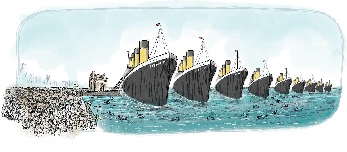1.6 Did You Ever Wonder…? - NCERT class 7 maths Textbook - Ganita Prakash
1.6 Did You Ever Wonder…?
“Screen Readable NCERT Class 7 Mathematics Textbook – Ganita Prakash – for Blind and Visually Impaired Students prepared by Professor T K Bansal.”
Estu is amused by all these interesting facts about large numbers. While thinking about these, he came up with an unusual question, “Could the entire population of Mumbai be fitted into 1 lakh buses?”
What do you think?
How can we find out?
Let us assume that a bus can accommodate 50 people. Then 1 lakh buses can accommodate 1 lakh × 50 = 50 lakh people.
The population of Mumbai is more than 1 crore 24 lakhs (we saw this in an earlier table). So, the entire population of Mumbai cannot be fitted in 1 lakh buses.
The RMS Titanic ship carried about 2500 passengers. Can the population of Mumbai be fitted into 5000 such ships?
Figure 1.21

Inspired by this strange question, Roxie wondered, “If I could travel 100 kilometers every day, could I reach the Moon in 10 years?”
(The distance between the Earth and the Moon is 3,84,400 km.)
How far would she have travelled in a year?
How far would she have travelled in 10 years?
Is it not easier to perform these calculations in stages? You can use this method for all large calculations.
Find out if you can reach the Sun in a lifetime, if you travel 1000 kilometers every day. (You had written down the distance between the Earth and the Sun in a previous exercise.)
Make necessary reasonable assumptions and answer the questions below:
(a) If a single sheet of paper weighs 5 grams, will you be able to lift one lakh sheets of paper together at the same time?
(b) If 250 babies are born every minute across the world, will a million babies be born in a day?
(c) Can you count 1 million coins in a day? Assume you can count1 coin every second.
Think and create more such fun questions and share them with your class mates.
Exercise 1.6 Figure it Out
Question 1.
Using all digits from 0 - 9 exactly once (the first digit cannot be 0) to create a 10-digit number, write the:
(a) Largest multiple of 5
(b) Smallest even number
Question 2.
The number 10,30,285 in words is Ten lakhs thirty thousand two hundred and eighty-five, which has 43 letters. Give a 7-digit number-name which has the maximum number of letters.
Question 3.
Write a 9-digit number, where exchanging any two digits results in a bigger number. How many such numbers exist?
Question 4.
Strike out 10 digits from the number 12345123451234512345, so that the remaining number is as large as possible.
Question 5.
The words ‘zero’ and ‘one’ share letters ‘e’ and ‘o’. The words ‘one’ and ‘two’ share a letter ‘o’, and the words ‘two’ and ‘three’ also share a letter ‘t’. How far do you have to count to find two consecutive numbers which do not share an English letter in common?
Question 6.
Suppose you write down all the numbers 1, 2, 3, 4, …, 9, 10, 11, ... The tenth digit you write is ‘1’ and the eleventh digit is ‘0’, as part of the number 10.
(a) What would the 1000th digit be? At which number would it occur?
(b) What number would contain the millionth digit?
(c) When would you have written the digit ‘5’ for the 5000th time?
Question 7.
A calculator has only ‘+10,000’ and ‘+100’ buttons. Write an expression describing the number of button-clicks to be made for the following numbers:
(a) 20,800
(b) 92,100
(c) 1,20,500
(d) 65,30,000
(e) 70,25,700
Question 8.
How many lakhs make a billion?
Question 9.
You are given two sets of number-cards numbered from 1 - 9. Place a number card in each box below to get the
(a) largest possible sum
(b) smallest possible difference of the two resulting numbers.
Question 10.
You are given some number-cards; 4000, 13000, 300, 70000, 150000, 20, 5. Using the cards get as close as you can to the numbers below using any operation you want. Each card can be used only once for making a particular number.
(a) 1,10,000: Closest I could make is 4000 × (20 + 5) + 13000 = 1,13,000
(b) 2,00,000:
(c) 5,80,000:
(d) 12,45,000:
(e) 20,90,800:
Question 11.
Find out how many coins should be stacked to match the height of the Statue of Unity. Assume each coin is 1 mm thick.
Question 12.
Grey-headed albatrosses have a roughly 7-feet wide wingspan. They are known to migrate across several oceans. Albatrosses can cover about 900 – 1000 km in a day. One of the longest single trips recorded is about 12000 km. How many days would such a trip take to cross the Pacific Ocean approximately?
Question 13.
A bar-tailed godwit holds the record for the longest recorded non-stop flight. It travelled 13,560 km from Alaska to Australia without stopping. Its journey started on 13 October 2022 and continued for about 11 days. Find out the approximate distance it covered every day. Find out the approximate distance it covered every hour.
Question 14.
Bald eagles are known to fly as high as 4500 – 6000 m above the ground level. Mount Everest is about 8850 m high. Aero planes can fly as high as 10000 – 12800 m. How many times bigger are these heights compared to Somu’s building?
